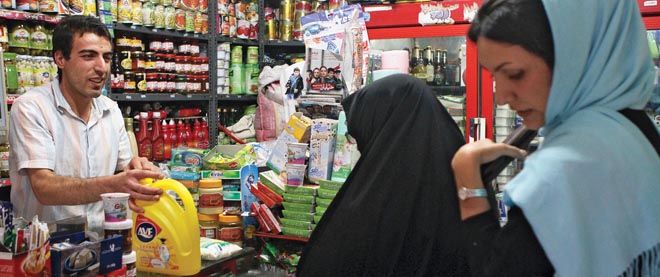Iran: revenge of the market
Economic sanctions resulting in runaway inflation and stagnant wages prompt protests
ATTA KENARE/AFP/Getty Images
Share

Western economic sanctions against Iran over its nuclear program may not be provoking much movement at the bargaining table, but they appear to be causing increasing unrest in its streets. Authorities moved to shut down unofficial money-changers in Tehran last week, after a currency panic saw the value of the rial fall by more than 40 per cent and provoked demonstrations. The protests, while relatively small, underscored a harsh new reality for the regime of Mahmoud Ahmadinejad: as the country’s oil exports are slowly choked off, the cost of almost everything is rising—and with it public discontent.
This summer, there was widespread anger when the price of chicken almost tripled over a two-month period. The cost of a container of yogourt has more than doubled since September, along with other staples like bread and milk. Following Ahmadinejad’s decision to abolish government subsidies for a whole host of basic goods in 2010, prices have been steadily on the rise. And within the last few weeks, they have been skyrocketing.
According to official Iranian government figures, unemployment sits at 12 per cent and the country’s annual inflation rate is about 25 per cent. But outside observers believe the reality is far worse, with more than a third of the workforce now jobless, prices doubling every 40 days, and the annual inflation rate closing in on 200 per cent. “They are definitely experiencing hyperinflation. All you have to do is look at the way the currency is trading on the black—or in this case, free—market,” says Steve Hanke, a professor of applied economics at Johns Hopkins University in Baltimore. “The economy is a mess.”
Faced with rising prices and stagnant wages—the average monthly salary is somewhere between US$95 and $220—Iranians have been rushing to convert their savings into more stable foreign currencies. When authorities stepped in last week, the rial was trading at around 37,500 to the U.S. dollar, having lost a third of its value in just 10 days. The official exchange rate is now pegged at 28,500 rials to the greenback. Government attempts to mollify public anger—like the 450,000-rial monthly payment now received by nearly 60 million Iranians—may be contributing to the inflation problem by flooding the market with increasingly worthless currency.
But even as evidence of the sanctions’ bite mounts, the bigger question remains: are they actually going to work as designed and force Ahmadinejad to stop enriching uranium? Even with its exports hobbled, Iran may still be able to maintain a positive trade balance through its strategy of offering deep discounts to long-time oil customers like China and Singapore. And International Monetary Fund forecasts released this week predict that Iran will both reduce inflation and grow its GDP in the coming year. Sitting on more than US$100 billion in foreign currency reserves, and buoyed by global oil prices that are now north of $114 a barrel, the regime may be able to limp on for quite some time—all the while whipping up public anger against the West.
As Hanke notes, economic sanctions have propped up more despotic regimes than they have toppled. “The Iranian economy is a completely mismanaged mess. But it’s been that way since the Shah was in power,” he says. Floating on a sea of oil makes up for a lot of bad policy and bizarre behaviour. Just look how long Saddam Hussein and Moammar Gadhafi lasted in their roles.